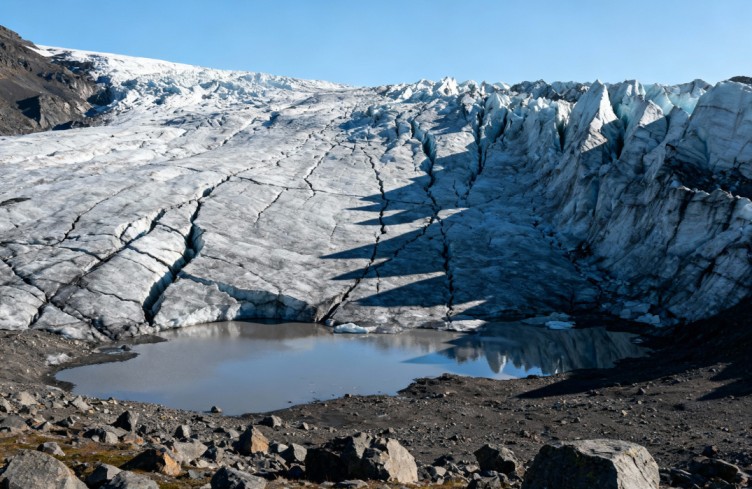Melting glaciers around the world provide frightening evidence of what climate change is doing to our planet. Glaciers, which have stored fresh water as ice for the past 20,000 years, are now disappearing rapidly, and with their going we lose stored drinking water. For instance, on the contested border between India and Pakistan, the glaciers that have provided drinking water for millennia will vanish in the next 30 or so years. With them will go the water that feeds the Indus River in Pakistan and much of India’s available ground water. Water supplies for these two very large, very water-dependent nations are limited and are contested. In India, the life-supporting monsoons are arriving at irregular intervals, with corresponding damage to drinking water supplies and to crops. In Pakistan, the thousands of glaciers are now rapidly dwindling, leaving diminishing tarns and kettle lakes behind them. What’s happening to the climate is bad enough, but the political squabbles between these to prominent nations lend weight to the geologic problem.
Understanding Glacial Retreat
Glacial retreat means that glaciers are losing more ice through melting and sublimation than they gain from snowfall accumulation. While natural cycles have historically caused glaciers to advance and retreat, the rapid pace observed today is driven primarily by human-induced climate change. Since the late 19th century, rising global temperatures fueled by greenhouse gas emissions from burning fossil fuels have heated the atmosphere and oceans, accelerating ice loss across regions from the Alps to Alaska and Iceland to the Himalayas.
Key scientific research affirms that nearly all the world’s monitored glaciers are in retreat. For example, mountain glaciers have lost substantial ice mass, contributing to rising sea levels that threaten coastal communities globally. According to ongoing studies, about 99% of glacial ice lies in vast polar ice sheets, yet even smaller alpine glaciers are critical indicators of climate health as they respond sensitively to temperature fluctuations and changing precipitation patterns.
Causes Behind the Retreat
The primary cause behind glacier retreat is climate change or global warming, driven by the accumulation of greenhouse gases such as carbon dioxide and methane. These gases trap heat in the Earth’s atmosphere, warming air temperature and surface waters. This warming melts glaciers faster than snowfall can replenish them. Other contributory factors include:
- The albedo effect: As glaciers melt, exposing darker land and ocean surfaces, more solar radiation is absorbed rather than reflected, accelerating warming in a positive feedback loop.
- Reduced snowfall or altered precipitation patterns under changing climate regimes.
- Warming ocean waters that erode glaciers from below, especially in coastal glaciers and ice shelves.
- Airborne soot and black carbon that settles on ice surfaces, decreasing reflectivity and increasing melt rates.
Glacial Retreat Facts
Glacial retreat has far-reaching consequences beyond loss of ice. It disrupts the freshwater supply for millions of people dependent on meltwater for drinking, agriculture, and hydroelectric power. Melting ice contributes significantly to sea level rise, increasing coastal erosion and the frequency of damaging storms. Changes in glacier-fed ecosystems also affect wildlife, from alpine flora to polar bears and walruses in the Arctic, whose habitats shrink as ice disappears.
Moreover, rapid ice loss destabilizes mountain slopes, raising the risks of landslides, avalanches, and floods. The exposure of new, previously ice-covered land also leads to the formation of glacial lakes which can burst and cause catastrophic flooding downstream.
Art and Photography: Emotional Truths of Glacial Loss
While scientific data and satellite imagery track glacier retreat, artistic expressions bring a vital emotional and human dimension to the issue. Eric Hatch, a fine-art photographer and writer, uses his lens to document the fragile, vanishing beauty of glaciers in remote northern landscapes such as the Yukon, Alaska, and Iceland. His collections, like “Glaciers in Retreat,” are more than photographs; they are visual stories that evoke the profound loss and urgency behind the numbers.
Photography captures not only the natural grandeur but also the tangible impact on surroundings and communities. Black and white portraits and environmental images offer a poignant reflection on ice retreat and broader social issues linked to the climate crisis. Through abstraction and detailed study of nature’s textures and forms, such work invites viewers to engage emotionally, fostering deeper awareness and motivation for climate action.
Conclusion: Facing a Melting Future
The retreat of glaciers exemplifies the accelerating changes wrought by climate warming—changes visible from mountain peaks to polar coasts. Combating this alarming trend demands urgent reduction of emissions, policies to protect vulnerable ecosystems, and global cooperation. Simultaneously, harnessing the combined power of science and art can strengthen public understanding and inspire collective responsibility.
Eric Hatch’s photographic journey through the vanishing icy realms reminds us that beyond the numbers and projections lie profound stories of transformation—stories that challenge us to act for the future of the planet and all its inhabitants.

